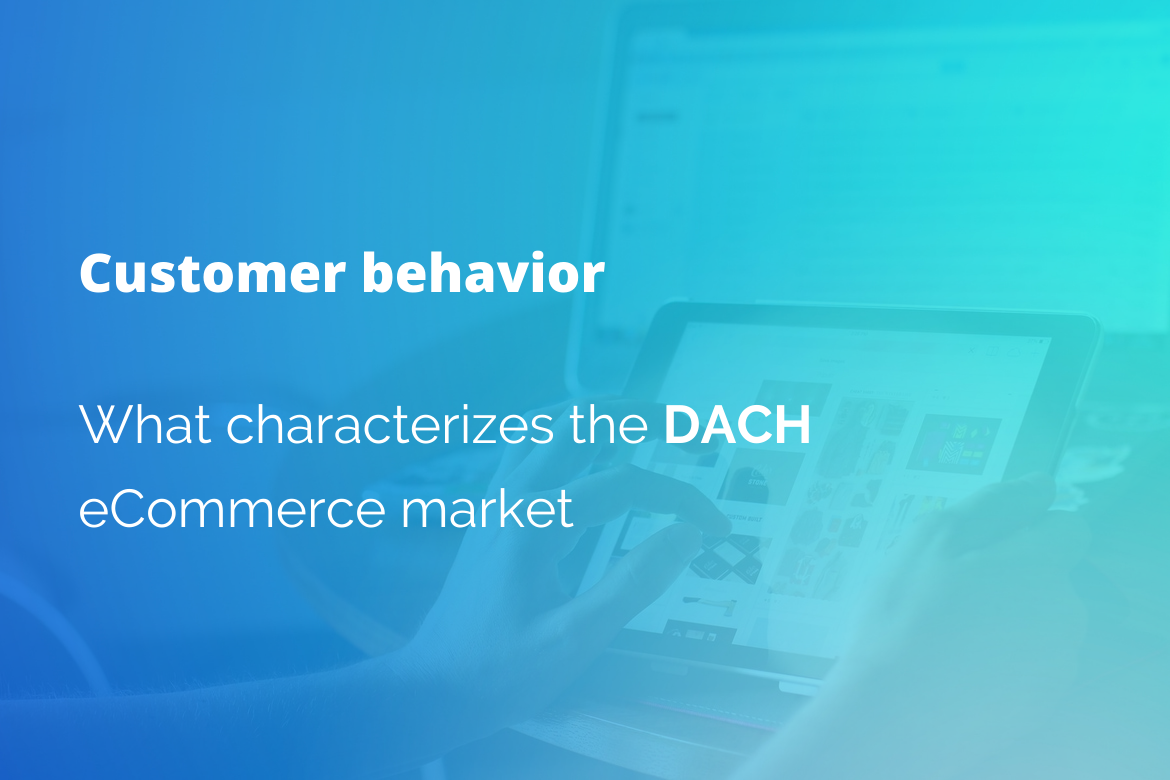Customer behavior: what characterizes the DACH eCommerce market?
Written by
Editorial TeamPublished on
Explore the characteristics of customer behavior in the DACH eCommerce scene. Unlock valuable tips to tailor your strategies for better engagement and sales!

More and more DACH companies are reaching out to price monitoring tools to get a better understanding of their competition and provide better customer service. So, can price monitoring tools help in understanding customer behavior? What are the main characteristics of the DACH eCommerce market? How are eCommerce brands and retailers in this region adjusting their businesses to customers’ needs and expectations?
Although eCommerce has been around for a long time, new things are being discovered almost daily. The main reason for this is customer behavior, or rather, changes in consumer habits. Each country and region has its specifics, and one of the regions that eCommerce professionals are particularly interested in is the DACH market.
The economic strength of this region is also reflected in eCommerce opportunities. Therefore, many brands and retailers are trying to find out as much as possible about their customers and the competition.
To better explain this somewhat complex topic, we will break it down into several segments:
- Explaining the DACH market
- Learning more about customer behavior
- Last but not least, find out what brands and retailers can do to improve their business
So, let’s dive in.
What characterizes the DACH eCommerce market?
First things first.
In case some of the readers are not familiar with this term, the DACH market stands for Germany, Austria, and Switzerland (Deutschland, Austria, and Confœderatio Helvetica). Even though it includes only 3 countries, this market is huge – there are around 100 million customers.
Since these three countries are geographically connected and have many economic similarities, eCommerce professionals tend to treat them as a whole.
Despite their similarities, it would be wise to explain each country a bit more to get a better understanding of customer behavior.
Germany
Alongside the United Kingdom and France, Germany is stepping into 2025 as a powerhouse in European eCommerce, with fresh energy, smart growth, and bold forecasts heading forward.
ECommerce worth in Germany keeps growing. For example, in 2020, the eCommerce in Germany reached an estimated €83.3 billion. As we all know, a pandemic took over the world by storm in 2020, so it was realistic to expect further increases. That’s exactly what happened – online revenue expected this year is $106.23 billion. With an 11.21% CAGR forecast to 2030.
For those of you who are big fans of numbers, let’s share another interesting fact. In the first half of the year, goods sold online hit €39.84 billion, growing 3.5% YoY. Q2 even ticked up to 3.8% growth. It’s nominal growth, yes, yet it marks a clean turn from the 2023–24 dip. Brands that stayed disciplined on pricing, delivery, and returns are seeing the payoff.
Germans have, undoubtedly, accepted eCommerce shopping as a new normal practice.
Analysts expect online to reach ~15.5% of total retail by the end of 2025, with marketplaces taking a slightly bigger slice than last year. For many sellers, this is where demand sits, where new shoppers land, and where Chinese newcomers keep the pressure high on price and speed.
And where are all these people spending their money? Well, the division in the German eCommerce market seems rather simple. Two main big players stand out – Amazon and Otto.
Payments remain wonderfully “German.” PayPal and wallets lead the way. Invoice/purchase on account still converts like nothing else for hesitant buyers. Direct debit holds its spot, and BNPL is now mainstream thanks to Klarna and friends. If you sell here, stack options to reduce drop-offs at checkout.
So, the shift in customer behavior towards online shopping is very clear.
Another interesting fact about customer behavior is that men tend to spend more than women, but women shop more often.
Austria
Austria is another country that is part of the DACH market. Its eCommerce market is settling into steady growth, not uprising fireworks, but riding solid momentum.
Austrian consumers spend around €11.6 billion online – that’s about €1,270 per person. Online purchases make up 15.5% of all retail spending, edging closer to the 2026 projection high. The CAGR of this eCommerce market is near 9.2% through 2029, putting the market at around $12.2 billion in 2025. On the other hand, Mordor Intelligence puts the 2025 value at $13.45 billion with a more modest 6.1% CAGR to 2030.
Unlike Germany where the disproportion between domestic and abroad online shopping is not so drastic (even though the numbers do incline more in favor of abroad ordering) the situation in Austria is different. This market is mostly dominated by international eCommerce companies.
The biggest eCommerce player in Austria is Amazon.de. That’s not unusual since Amazon is regionally based in Germany, so Austria is one of the closest markets. Besides Amazon, the two other major players are Zalando.at and Mediamarkt.at
As we can notice, customer behavior in this country is very much shaped by online practices.
And what do Austrians buy the most? Clothing, electronics, and furniture are big-ticket categories. Clothing alone pulls in about €2.4 billion, appliances around €1.3 billion, and furniture roughly €0.9 billion. Toys and sports gear have the highest online share per category—35% and 34% respectively.
When it comes to customer behavior related to gender shopping, the situation is similar to in Germany. Women tend to shop more frequently, but men spend more money.
Switzerland
As some readers might know, Switzerland is one of the founding member countries of the European Free Trade Association, but it’s not a part of the European Union. Switzerland is also not a member of the European Economic Area, but this doesn’t prevent this small country from being one of the most developed European economies.
In 2025, Switzerland’s e‑commerce market hit around $18.19 billion, and it’s set to climb to over $34.21 billion by 2030. Yes, growing at a healthy 13.5% CAGR. That’s driven by fast internet, high incomes, and tech-savvy shoppers.
And social commerce is catching fire. It’s expected to grow 13.2% in 2025, reaching $3.24 billion, and trending toward $5.1 billion by 2030 as influencers and in-app shopping become even more seamless.
Unlike the other two countries, the customer behavior of Swiss consumers shows a clear focus on the domestic market. Digitec Galaxus leads with CHF 2.744 billion in 2023 sales. They mix a huge product range, omnichannel showrooms, and ultra-fast delivery – even same-day delivery in Zurich for ~60% of households by 2023.
Customer behavior also shows a tendency to shop at Amazon and Zalando. The most popular product categories are Fashion with 24.02% and Food with 16.4%.
A very important reason behind the eCommerce popularity in this country lies in the fact that customers usually have trust in their retail sector. Swiss customers just find online shopping completely safe.
So now that we have a good understanding of the DACH market, we can have a more precise idea about what the retailers’ plan of action should be.
Focus on the marketplaces
As the rows above clearly show, the DACH eCommerce market is very focused on marketplaces. Customers in these 3 countries seem mostly focused on Amazon, and also on domestic retailers, such as Otto.de, Zalando, and Digitec.ch.
Marketplaces in DACH double as trust signals. Shoppers know they’ll get reliable shipping, easy online returns, and clear communication: standards they don’t automatically expect from a lesser-known online store. That means listing your products on these platforms can be the fastest route to visibility, especially if you’re new to the region.
To win here, think beyond just “listing” your products. Optimize for marketplace search, invest in professional imagery, and run targeted ads within these platforms. Consider exclusive SKUs or bundles to stand out from the dozens of similar listings. And don’t ignore marketplace data – these insights can shape your pricing, product mix, and even your standalone store strategy.
The increasing popularity of mCommerce
The popularity of mCommerce is growing all over the world, so the same trend is affecting the DACH market. Mobile-friendliness is one of the crucial factors in customer behavior.
Why? Simple – it’s convenient.
Germans tend to use smartphones mainly as a research tool before buying. Nearly half use them to look up products online, and more than a third read reviews before making a decision. Many also turn to retailer apps or in-store price checks to compare offers, whether against the shop’s own website or other retailers.
Search engines and even social media reviews play a smaller but still notable role, still showing that the phone is more of a pocket research assistant than an impulse-buy trigger.
Paying methods – what to focus on
One of the most important factors influencing customer behavior is payment.
While the DACH market shows many similarities to other aspects of customer behavior, the payment sector shows some differences. Germans still favor PayPal, e‑wallets, invoices, “pay‑later”, or account‑to‑account (A2A) methods (such as the upcoming Wero wallet, rolling out in mid‑2025 as a fast, seamless Euro‑based tool). Austrian and Swiss consumers continue relying on cash or credit and debit cards and domestic wallets like Twint in Switzerland, but they’re increasingly open to mobile wallets and instant payment options.
Meanwhile, security and low cost remain top considerations when consumers choose how to pay. For retailers, the winning strategy is a checkout that feels safe and local in their market. So, it would be good to offer native favorites plus a couple of emerging options to future-proof your sales.
How can DACH eCommerce brands and retailers improve their business?
As important as it is to understand customer behavior, it’s equally important to understand your competitors.
Depending on the market conditions and their own goals, competitors sometimes tend to make frequent price changes. Someone is aiming to offer the lowest price, someone just wants to do it for a certain time because it’s maybe entering a new market. On the other hand, some competitors want to set the highest price since it’s in alignment with their image of a quality product.
Why is this so important? Well, a brands’/retailers’ pricing strategy needs to be in alignment both with their own business goals and with the competitors’ actions.
Keeping track of all those changes, especially in competitive markets, can be a daunting task. Over the years, it became almost impossible to monitor all those changes manually. Prices just kept changing at such a fast pace that the need for an automated solution became obvious.
That’s when price monitoring tools have become so popular.
The first price monitoring tools appeared around 10 years ago, but their popularity was nowhere near today’s one. Nowadays, it’s impossible to run a successful online business without using such tools. They’re able to monitor different competitors and products while presenting everything in numerous reports. A very convenient thing is the alert email that you receive after the price change has been detected. In that way, everyone can act promptly and adjust their prices accordingly.
What industries are seeing the biggest change?
One of the price monitoring tools that pioneered this field around 10 years ago is Price2Spy. Therefore, we have witnessed several changes that eCommerce has gone through. Today, we can say with certainty that there is practically no industry in which price monitoring does not take place.
However, there are some industries where price monitoring is more feasible than in others. Mostly because these are industries where product matching can be done in an automated way:
- Consumer electronics
- Household appliances
- Car parts
Product matching can also be done manually, but what determines which approach will be applied is the characteristics of a given industry. Hence, automated product matching applies to the mentioned industries mostly because these products have standardized part numbers. That goes hand in hand with large product catalogs and a wide range of products. It’s important to note that product matching can be done in several ways – by product category, by brand, or by-product supplier.
When we talked about each country individually, we also dealt with the popularity of local and international online stores. It can be said that the data we get through Price2Spy over the years coincides with the regularities observed above.
Our clients from the DACH market are more focused on monitoring local competitors. In very few industries (books, for example) international stores were able to take a significant market share. There are quite a few reasons behind this, but one of the most important ones is related to shipping costs. It’s also important to note that a further increase in shopping costs can be expected, mostly due to the current situation in the world and the oil price surge.
Wrapping it up
So much has been said about customer behavior that many think they have learned everything they need to know. However, this complex topic is constantly evolving. The main reason for this is the global social and economic changes that inevitably affect the behavior of consumers around the world.
We have tried to bring customer behavior in the DACH market as close as possible since we believe that this is one of the markets with the greatest potential.
Hope you’ll find this overview useful!
***
—

Misha Krunic is the founder and the CEO of Price2Spy. With a rich career in the IT sector and eCommerce, he founded WEBCentric (Price2Spy’s mother company) 18 years ago. After 6 years, price monitoring stood out as a major service that could no longer be manually performed, so Misha came up with the idea of founding Price2Spy. Since then, Price2Spy is one of the world’s leading price monitoring tools and it has over 750 satisfied clients, worldwide.


